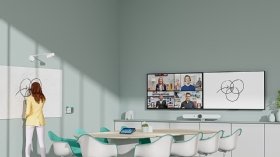
olly - Fotolia
Logitech launches video conferencing whiteboard camera
Logitech's Scribe camera levels the playing field for video conferencing meetings, letting both remote and in-person attendees see the writing on a whiteboard.
Logitech has launched a camera called the Scribe that captures writings and drawings on a physical whiteboard in real-time and displays them for video conference attendees.
The company released the $1,199 camera on Tuesday, competing with whiteboard-capture offerings from Kaptivo and Huddly. The Scribe mounts on a conference room wall and hangs above a whiteboard, broadcasting what's on it to remote attendees. The camera can film whiteboard surfaces of up to 6 feet by 4 feet.
Scribe uses built-in AI to let people see the part of the whiteboard that's blocked by a presenter's arm while writing. The camera's AI also enhances the color of the whiteboard content -- and the writing on Post-it notes stuck to the board -- making it easier to see.
Scribe has built-in integrations with the Microsoft Teams Rooms and Zoom Rooms products for conference rooms. When using Teams or Zoom, the presenter can press either a wireless button or a meeting room touch controller to begin sharing whiteboard content. Companies can use the Scribe with other video conferencing applications as well, but without the one-touch sharing option.
Logitech said the camera improves the video conference experience for remote attendees by making them feel more like a participant in a physical meeting.

Logitech executive Simon Dudley also said the camera is a less expensive alternative to interactive whiteboard displays, which cost $3,000 or more. Rather than buy the latter, companies can use the camera with the physical whiteboard in most conference rooms.
Zeus Kerravala, founder of ZK Research, said online whiteboard apps and interactive displays are less intuitive than writing with a marker on a physical whiteboard.
"If you can [capture a] whiteboard with a camera, that gives you the best of both worlds," he said. "People like the ability to stand up at a whiteboard with a pen and write on it. None of the electronic whiteboard manufacturers have figured out how to simulate the feeling of writing on a plain board."
Mike Gleason is a reporter covering unified communications and collaboration tools. He previously covered communities in the MetroWest region of Massachusetts for the Milford Daily News, Walpole Times, Sharon Advocate and Medfield Press. He has also worked for newspapers in central Massachusetts and southwestern Vermont and served as a local editor for Patch. He can be found on Twitter at @MGleason_TT.







